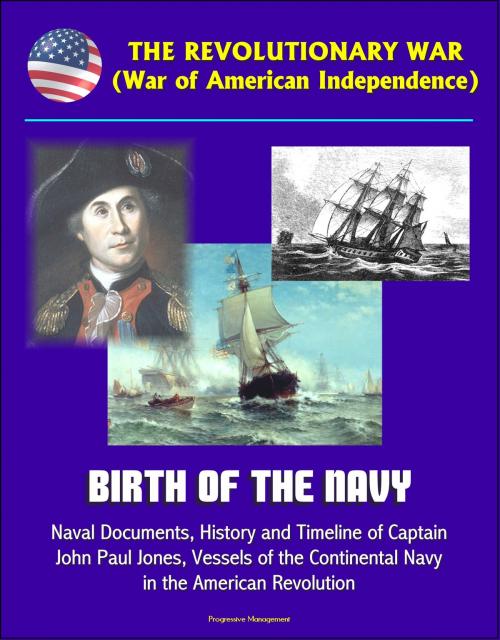The Revolutionary War (War of American Independence): Birth of the Navy, Naval Documents, History and Timeline of Captain John Paul Jones, Vessels of the Continental Navy in the American Revolution
Nonfiction, History, Americas, United States, Revolutionary Period (1775-1800), Military| Author: | Progressive Management | ISBN: | 9781301687107 |
| Publisher: | Progressive Management | Publication: | October 18, 2012 |
| Imprint: | Smashwords Edition | Language: | English |
| Author: | Progressive Management |
| ISBN: | 9781301687107 |
| Publisher: | Progressive Management |
| Publication: | October 18, 2012 |
| Imprint: | Smashwords Edition |
| Language: | English |
This unique historical compilation provides comprehensive information on the role of naval power in the American Revolution, including the birth of the U.S. Navy, naval documents, a comprehensive history and timeline of Captain John Paul Jones, and a full list of the vessels of the Continental Navy, with numerous detailed descriptions.
Contents: The Birth of the Navy of the United States * Naval History Bibliographies * Congress and the Continental Navy, 1775-1783: Chronology and Documents * Captain John Paul Jones * Vessels of the Continental Navy * Timeline for the Revolutionary War, the Schooner Dolphin, George Barber, and William Middleton * The Submarine Turtle
On Friday, October 13, 1775, meeting in Philadelphia, the Continental Congress voted to fit out two sailing vessels, armed with ten carriage guns, as well as swivel guns, and manned by crews of eighty, and to send them out on a cruise of three months to intercept transports carrying munitions and stores to the British army in America. This was the original legislation out of which the Continental Navy grew and as such constitutes the birth certificate of the navy.
As an officer of the Continental Navy of the American Revolution, John Paul Jones helped establish the traditions of courage and professionalism that the Sailors of the United States Navy today proudly maintain. John Paul was born in a humble gardener's cottage in Kirkbean, Kirkcudbrightshire, Scotland, went to sea as a youth, and was a merchant shipmaster by the age of twenty-one. Having taken up residence in Virginia, he volunteered early in the War of Independence to serve in his adopted country's infant navy and raised with his own hands the Continental ensign on board the flagship of the Navy's first fleet. He took the war to the enemy's homeland with daring raids along the British coast and the famous victory of the Bonhomme Richard over HMS Serapis. After the Bonhomme Richard began taking on water and fires broke out on board, the British commander asked Jones if he had struck his flag.
Presented here is a collection of documents that concern the submersible Turtle, the world’s first combat submarine. Named Turtle because its inventor, David Bushnell, believed the craft resembled “two upper tortoise shells of equal size, joined together,” it saw action in the first days of the American Revolution. Designed in 1771-1775 while Bushnell was a Yale College undergraduate, it embodied the four basic requirements for a successful military submarine: the ability to submerge; the ability to maneuver under water; the ability to maintain an adequate air supply to support the operator of the craft; and the ability to carry out effective offensive operations against an enemy surface vessel.
This unique historical compilation provides comprehensive information on the role of naval power in the American Revolution, including the birth of the U.S. Navy, naval documents, a comprehensive history and timeline of Captain John Paul Jones, and a full list of the vessels of the Continental Navy, with numerous detailed descriptions.
Contents: The Birth of the Navy of the United States * Naval History Bibliographies * Congress and the Continental Navy, 1775-1783: Chronology and Documents * Captain John Paul Jones * Vessels of the Continental Navy * Timeline for the Revolutionary War, the Schooner Dolphin, George Barber, and William Middleton * The Submarine Turtle
On Friday, October 13, 1775, meeting in Philadelphia, the Continental Congress voted to fit out two sailing vessels, armed with ten carriage guns, as well as swivel guns, and manned by crews of eighty, and to send them out on a cruise of three months to intercept transports carrying munitions and stores to the British army in America. This was the original legislation out of which the Continental Navy grew and as such constitutes the birth certificate of the navy.
As an officer of the Continental Navy of the American Revolution, John Paul Jones helped establish the traditions of courage and professionalism that the Sailors of the United States Navy today proudly maintain. John Paul was born in a humble gardener's cottage in Kirkbean, Kirkcudbrightshire, Scotland, went to sea as a youth, and was a merchant shipmaster by the age of twenty-one. Having taken up residence in Virginia, he volunteered early in the War of Independence to serve in his adopted country's infant navy and raised with his own hands the Continental ensign on board the flagship of the Navy's first fleet. He took the war to the enemy's homeland with daring raids along the British coast and the famous victory of the Bonhomme Richard over HMS Serapis. After the Bonhomme Richard began taking on water and fires broke out on board, the British commander asked Jones if he had struck his flag.
Presented here is a collection of documents that concern the submersible Turtle, the world’s first combat submarine. Named Turtle because its inventor, David Bushnell, believed the craft resembled “two upper tortoise shells of equal size, joined together,” it saw action in the first days of the American Revolution. Designed in 1771-1775 while Bushnell was a Yale College undergraduate, it embodied the four basic requirements for a successful military submarine: the ability to submerge; the ability to maneuver under water; the ability to maintain an adequate air supply to support the operator of the craft; and the ability to carry out effective offensive operations against an enemy surface vessel.















